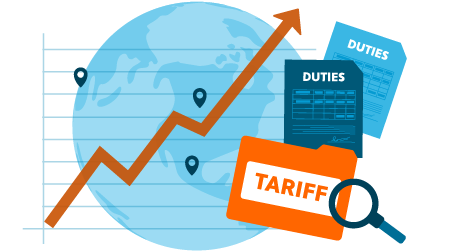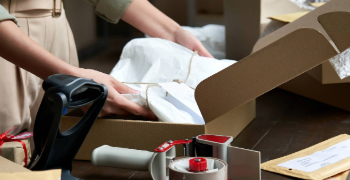
De minimis exemption changes are coming: Is your business ready?
This post has been updated to reflect new developments. It was originally published on November 6, 2024.
Duty-free, low-value shipments are inundating United States Customs and Border Protection (CBP), and “bad actors” are exploiting the expedited import process to smuggle illegal and harmful goods into the country. Changing the de minimis exemption could help stem the flow of illegal low-value imports.
What is the de minimis exemption for customs duties?
The de minimis exemption allows many goods valued at or under $800 (per person, per day) to enter the United States exempt from duty and import taxes. De minimis is authorized under Section 321(a)(2)(c) of the Tariff Act of 1930, so these imports are often called Section 321 Entries.
Roughly 100 countries/territories have de minimis thresholds, but the U.S. threshold is by far the most generous. Congress raised the de minimis threshold from $200 to $800 (per person per day) in March 2016. The $800 value is based on the aggregate fair retail value in the country of shipment.
How does CBP process Section 321 Entries?
A few different customs entry processes are available for Section 321 Entries, including:
- Release from manifest process, an informal entry process with simplified documentation requirements and clearance procedures. This option is not available for shipments subject to the Partner Government Agencies (PGA) regulation.
- Entry Type 86, a more formal entry process suitable for all Section 321 shipments. This option is available for PGA shipments and low-value imports subject to other oversights.
Release from manifest process
The following information is required for shipments entering the country via a release from manifest entry:
- Country of origin of the merchandise
- Merchandise description (specific)
- Value, quantity, and shipping weight of goods
- Shipper name, address, and country
- Ultimate consignee name and address
The following information isn’t required but may be provided:
- Entry summary
- Harmonized Tariff Schedule of the United States codes (HTSUS codes, also called Harmonized System or HS codes)
Entry Type 86
The following information is required for shipments using Entry Type 86, or T86:
- Bill of lading or the air waybill number
- Consignee name and address
- Country of origin
- Entry number
- Fair retail value in the country of shipment
- Importer of record (IOR) number of the owner, purchaser, or broker (required when the shipment is subject to PGA data reporting requirements)
- Planned port of entry
- Quantity
- Shipper name, address, and country
- HSTUS code
T86 documents must be filed electronically through CBP’s Automated Commercial Environment (ACE) portal. Before February 15, 2024, importers had up to 15 days after arrival of the cargo to provide the necessary information. Today, documents are due before or upon reaching customs.
There’s yet another entry process for postal shipments.
Parcels arriving by mail
The documents required for low-value shipments sent by mail generally include:
- Customs declaration
- Invoice or bill of sale (or other statement showing the fair retail value in the country of shipment)
Qualifying low-value shipments sent through the mail are generally accepted without an entry and free from duty and import tax.
How many de minimis imports enter the U.S.?
There were more than 1.36 billion de minimis shipments in 2024. While in theory “CBP monitors/reviews shipments the same regardless of value,” in reality, customs officials are struggling to keep up with the tsunami of low-value imports arriving in the U.S. each day.
At New York’s John F. Kennedy International Airport alone, the entry point for 25% of all de minimis shipments, CBP often receives and processes between 750,000 and 1 million de minimis shipments each day. Nationwide, CBP daily processes close to 4 million de minimis shipments.
To put these figures into perspective, CBP processed approximately 139 million de minimis transactions in 2015, when the de minimis threshold was a quarter of what it is today.
At certain points of entry, the volume of low-value shipments is overwhelming customs officials. “We have limited resources,” explains Andrew Renna, Assistant Port Director for Cargo Operations at JFK Airport. “There is no physical way if I doubled or even tripled my staffing that I could look at a significant percentage of [750,000 to 1 million de minimis shipments].”
Yet CBP does scrutinize many low-value imports, and in doing so has discovered plenty of illegal goods: fentanyl and drug-making paraphernalia; counterfeit goods; smuggled beef, pork, and poultry declared as footwear and jackets; textiles produced by forced labor; and weapons hidden inside chocolate, to name just a few.
And therein lies the problem changing the de minimis exemption could help solve: De minimis is “a very exploitable mode of entry into the U.S.,” says Renna.
What are the U.S. de minimis exemption changes?
The Biden White House announced a plan in September 2024 “to stop the abuse of the de minimis exemption.” It included:
A proposed rule imposing tariffs on goods that injure or threaten domestic industry or national security
A proposed rule requiring additional data for de minimis shipments
A final rule requiring importers to file electronic certificates of compliance with CBP and the Consumer Product Safety Commission (CPSC) at the point of entry
The Biden administration also called on Congress to “reform the de minimis exemption comprehensively.” It was particularly interested in stopping harmful drugs from illegally entering the U.S. and preventing imports of apparel and textile products made by forced labor (e.g., the Uyghurs in China).
This mantle has been picked up by the Trump administration, which will recommend modifications to the $800 duty-free de minimis threshold by April 1, 2025. In the meantime, CBP is forging ahead with the plan introduced last September.
New tariffs on goods that threaten domestic industry or national security
On January 17, 2025, CBP proposed a new rule to exclude from the de minimis exemption all shipments containing products covered by tariffs imposed under Section 201 or Section 301 of the Trade Act of 1974, or Section 232 of the Trade Expansion Act of 1962. These sections govern products that injure or threaten domestic businesses or national security.
These proposed rules would also “ensure that de minimis exemption eligibility for products covered by trade enforcement actions is consistent across U.S. trade laws,” as set out in September 2024.
Greater enforcement for de minimis shipments
On January 13, 2025, CBP issued the Entry of Low-Value Shipments (ELVS) Notice of Proposed Rulemaking (NPRM). It should enhance supply chain visibility and CBP’s ability to prevent illegal de minimis shipments from entering the country.
The proposed rule seeks to revise the process for entering low-value shipments by requiring additional data and creating a fully electronic process for filers to transmit entry data prior to a shipment’s arrival. It would:
Require specific, additional data for de minimis shipments, including the 10-digit tariff classification number and the person claiming the de minimis exemption
Clarify who is eligible for the administrative exemption and require filers to identify the person on whose behalf the exemption is being claimed
“10-digit HTS codes are already required for a majority of clearance processes,” explains Shane Bogdan, Director of Cross-Border Sales at Avalara, “but not everyone is providing them, nor are they being classified accurately. In some instances, organizations may be just affixing four random digits (e.g., 0000) to the end of a 6-digit HS code to make it the required 10-digit code.”
Establishing more stringent collection requirements should give CBP better visibility into de minimis shipments.
The proposed rule would allow low-value shipments arriving by mail to be entered through the enhanced entry process. The customs declaration and invoice would need to be submitted electronically and received by CBP no later than the date the merchandise departs from the country of posting. De minimis mail shipments are not eligible to use the basic entry process.
The Biden White House encouraged Congress to pass the Detect and Defeat Counter Fentanyl Proposal as well. This would authorize CBP to demand additional documentation and information about de minimis packages to help it identify patterns and analyze risk.
It would also add a user fee to de minimis packages, to help pay for necessary equipment and staff. And it would set stronger penalties for using the de minimis exemption to smuggle illegal drugs into the country.
Improve consumer protection
Finally, CPSC intends to propose a final rule to prevent de minimis shipments from circumnavigating safety standards. The initial proposed rule was submitted in December 2023.
Importers of consumer products would be required to file Certificates of Compliance (CoC) electronically with CBP and CPSC at the time of entry — including for de minimis shipments, which currently don’t require a CoC. This would help CBP and CPSC identify unsafe products and prevent them from entering the U.S. market.
How changes to de minimis could impact ecommerce businesses
Delays and added costs are the two biggest potential fallouts of changing the de minimis import process.
Subjecting de minimis shipments to additional scrutiny could slow the process of clearing low-value, cross-border ecommerce packages. Ecommerce businesses shipping goods into the U.S. from other countries will therefore need to alert consumers of potential delays and plan accordingly.
In fact, some low-value imports may already be experiencing delays. On May 31, 2024, CBP announced that it had suspended multiple customs brokers from working with Entry Type 86 imports after discovering they’d cleared packages that “posed an unacceptable risk.”
According to Supply Chain Brain, customs brokers are now taking more care to ensure imports are legal because their reputations and licenses are on the line.
When will the de minimis changes take effect?
The fact sheet published by The Biden White House in September did not lay out a timeline; the Trump administration has requested a report on these issues by April 1, 2025. All proposed rules require public comment before being finalized.
Change by executive order, however, is another story.
On February 1, 2025, President Donald Trump issued three separate executive orders eliminating the de minimis exemption for Canada, Mexico, and the People’s Republic of China effective February 4. He paused the tariffs on de minimis shipments from Canada and Mexico before they took effect but allowed the tariffs on China to move forward. Then, on February 7, he paused the tariffs on de minimis shipments from China until “adequate systems are in place to fully and expediently process and collect tariff revenue.” Learn more about the tumultuous Trump tariffs.
With CBP cracking down on de minimis imports and President Trump keen on last-minute de minimis tariff changes, ecommerce businesses should be proactive and do all they can to streamline cross-border sales. Assigning the correct 10-digit HTS code to all low-value imports can help, as can confirming all imports comply with current trade restrictions.
“Accurate and complete HTS codes ensure streamlined processing through customs, increase trade visibility and efficiency, and help maintain the integrity of the supply chain,” says Bogdan. Given the heightened focus on compliance, international sellers that proactively adopt cross-border compliance solutions should be in the best position to avoid being held up at customs.
Avalara has a portfolio of services to help businesses comply with de minimis exemption requirements and trade restrictions. These include our HS code classification services: Automated Tariff Code Classification, Self-Serve Tariff Code Classification, and Managed Tariff Code Classification.
Schedule a call today for more details.

Simplify cross-border tariff compliance with automation
Stay ahead of changing trade regulations with automated tariff code classification and duty calculations
Stay up to date
Sign up for our free newsletter and stay up to date with the latest tax news.











